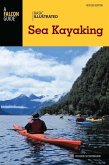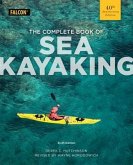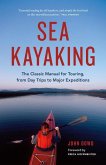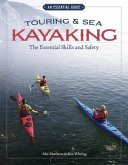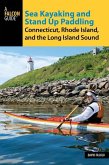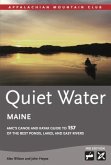Shelley Johnson
Sea Kayaker's Pocket Guide
11,99 €
inkl. MwSt.
Versandfertig in über 4 Wochen

6 °P sammeln
Shelley Johnson
Sea Kayaker's Pocket Guide
- Broschiertes Buch
- Merkliste
- Auf die Merkliste
- Bewerten Bewerten
- Teilen
- Produkt teilen
- Produkterinnerung
- Produkterinnerung
Like having a trusted guide at your side Ingenious, simple, and eminently practical, Sea Kayaker's Pocket Guide is all you need to get out on the water and start kayaking. Experienced kayak guide and instructor Shelley Johnson provides expert advice on pretrip planning, launching (and landing) your kayak, paddling tips, weather and navigation, safety and first aid, and leave-no-trace camping. This guide is illustrated throughout by helpful photographs and drawings. Next to your paddle, this book could be the most important item you pack. PACK IT and GO.
Andere Kunden interessierten sich auch für
![Basic Illustrated Sea Kayaking Basic Illustrated Sea Kayaking]() Roger SchumannBasic Illustrated Sea Kayaking12,99 €
Roger SchumannBasic Illustrated Sea Kayaking12,99 €![The Complete Book of Sea Kayaking The Complete Book of Sea Kayaking]() Derek C. HutchinsonThe Complete Book of Sea Kayaking27,99 €
Derek C. HutchinsonThe Complete Book of Sea Kayaking27,99 €![The Complete Whitewater Rafter The Complete Whitewater Rafter]() Jeff BennettThe Complete Whitewater Rafter24,99 €
Jeff BennettThe Complete Whitewater Rafter24,99 €![Sea Kayaking Sea Kayaking]() John DowdSea Kayaking18,99 €
John DowdSea Kayaking18,99 €![Touring & Sea Kayaking the Essential Skills and Safety Touring & Sea Kayaking the Essential Skills and Safety]() Ken WhitingTouring & Sea Kayaking the Essential Skills and Safety18,99 €
Ken WhitingTouring & Sea Kayaking the Essential Skills and Safety18,99 €![Sea Kayaking and Stand Up Paddling Connecticut, Rhode Island, and the Long Island Sound Sea Kayaking and Stand Up Paddling Connecticut, Rhode Island, and the Long Island Sound]() David FasuloSea Kayaking and Stand Up Paddling Connecticut, Rhode Island, and the Long Island Sound22,99 €
David FasuloSea Kayaking and Stand Up Paddling Connecticut, Rhode Island, and the Long Island Sound22,99 €![Quiet Water Maine: Amc's Canoe and Kayak Guide to 157 of the Best Ponds, Lakes, and Easy Rivers Quiet Water Maine: Amc's Canoe and Kayak Guide to 157 of the Best Ponds, Lakes, and Easy Rivers]() Alex WilsonQuiet Water Maine: Amc's Canoe and Kayak Guide to 157 of the Best Ponds, Lakes, and Easy Rivers18,99 €
Alex WilsonQuiet Water Maine: Amc's Canoe and Kayak Guide to 157 of the Best Ponds, Lakes, and Easy Rivers18,99 €-
-
-
Like having a trusted guide at your side Ingenious, simple, and eminently practical, Sea Kayaker's Pocket Guide is all you need to get out on the water and start kayaking. Experienced kayak guide and instructor Shelley Johnson provides expert advice on pretrip planning, launching (and landing) your kayak, paddling tips, weather and navigation, safety and first aid, and leave-no-trace camping. This guide is illustrated throughout by helpful photographs and drawings. Next to your paddle, this book could be the most important item you pack. PACK IT and GO.
Hinweis: Dieser Artikel kann nur an eine deutsche Lieferadresse ausgeliefert werden.
Hinweis: Dieser Artikel kann nur an eine deutsche Lieferadresse ausgeliefert werden.
Produktdetails
- Produktdetails
- Verlag: McGraw Hill LLC
- Seitenzahl: 144
- Erscheinungstermin: 22. Oktober 2001
- Englisch
- Abmessung: 205mm x 113mm x 7mm
- Gewicht: 154g
- ISBN-13: 9780071375283
- ISBN-10: 0071375287
- Artikelnr.: 21913529
- Herstellerkennzeichnung
- Libri GmbH
- Europaallee 1
- 36244 Bad Hersfeld
- gpsr@libri.de
- Verlag: McGraw Hill LLC
- Seitenzahl: 144
- Erscheinungstermin: 22. Oktober 2001
- Englisch
- Abmessung: 205mm x 113mm x 7mm
- Gewicht: 154g
- ISBN-13: 9780071375283
- ISBN-10: 0071375287
- Artikelnr.: 21913529
- Herstellerkennzeichnung
- Libri GmbH
- Europaallee 1
- 36244 Bad Hersfeld
- gpsr@libri.de
Shelley Johnson, is a registered Maine Guide and coastal kayak instructor certified by the American Canoe Association. Sea kayaking editor for Canoe & Kayak magazine, she is a frequent contributor to Atlantic Coastal Kayaker and Kayak Touring. She has taught sea kayaking and watersports safety courses throughout the United States and Canada.
Before You Go Trip Planning Having a Plan
Getting the Forecast
Timing the Tide Clothing and Equipment Staying Warm, Staying Dry
Staying Cool
Life Vests (PFDs)
Checking Your Gear
Adjusting the Fit Pretrip Details Who to Contact
Float Plan
Ten Essentials
Organizing Your Gear Launch Day Transporting Kayaks Kayaks on Cars
Carrying Your Kayak At the Beach or Dock Trimming and Packing the Boat
Launch Site Checklist Getting In and Out of Your Kayak At the Beach
Launching and Landing at a Dock
Launching in Surf On the Water Paddling Smart Paddle Grip
Moving Forward
Turning (Sweep Strokes)
Pacing
Crossing a Current (Ferrying)
Staying on Course Reading the Conditions Cloud Types
Beaufort Scale (Wind Speed Table)
Predicting Wind Direction
Weather Sayings and Observations
Wave Heights Group Travel Formations
Group Signals Challenges at Sea Strong Winds
Beam Seas
Following Seas
Squalls
Fog
Boat Traffic Night Paddling Traveling Safely
Night Signals Navigation Navigation Skills Compass Rose
Buoys
Light Characteristics
Latitude-Longitude Readings
Taking a Bearing
Line of Position
Ranges
Determining Speed of Travel
Determining a Fixed Point
Tidal Current Calculations
Where Am I? Electronic Navigation GPS Waypoints
Storing GPS Information On the Air VHF Radio Signals
VHF Radio Protocol Emergency Situations When Things Go Wrong Distress Signals
Lightning
Capsize!
Capsized Partner
Rescue Sling
Lost Kayaker When It's Time to Tow Towing in Seas
Close-Contact Towing
Stabilizing the Towed Paddler Going Ashore Getting There Landing Sites
Landing in Surf
Public Access Camping Choosing a Campsite
Setting Up Camp
Using Salt Water
How Much Water?
Leave-No-Trace Kayaking
Gray-Water Disposal
Waste Disposal Wildlife Sea Birds
Marine Mammals
Stranded Animals Field Repairs Boat Repairs Leaks
Composite (Cloth and Resin) Kayaks
Plastic Kayaks
Rudder and Skeg Jams
Jammed Foot Braces
Bulkhead Repairs Accessory Repairs Paddle Breaks
Jammed Paddle Ferrules
Vinyl (Dry Bags, etc.)
Dry Suits and Dry Tops
Neoprene First Aid Muscles and Joints Wrist Aches
Shoulder Aches
Dislocated Shoulder
Sprained Ankle
Backaches
Numb Feet Heat and Cold Sunburn
Dehydration
Hypothermia
Hyperthermia Nature's Offerings Salt-Water Rashes
Barnacle Cuts
Deer Ticks
Red Tide
Brown-Tail Moths
Poisonous Plants Frequent Complaints Blisters
Burns
Contact Lens Problems Index
Getting the Forecast
Timing the Tide Clothing and Equipment Staying Warm, Staying Dry
Staying Cool
Life Vests (PFDs)
Checking Your Gear
Adjusting the Fit Pretrip Details Who to Contact
Float Plan
Ten Essentials
Organizing Your Gear Launch Day Transporting Kayaks Kayaks on Cars
Carrying Your Kayak At the Beach or Dock Trimming and Packing the Boat
Launch Site Checklist Getting In and Out of Your Kayak At the Beach
Launching and Landing at a Dock
Launching in Surf On the Water Paddling Smart Paddle Grip
Moving Forward
Turning (Sweep Strokes)
Pacing
Crossing a Current (Ferrying)
Staying on Course Reading the Conditions Cloud Types
Beaufort Scale (Wind Speed Table)
Predicting Wind Direction
Weather Sayings and Observations
Wave Heights Group Travel Formations
Group Signals Challenges at Sea Strong Winds
Beam Seas
Following Seas
Squalls
Fog
Boat Traffic Night Paddling Traveling Safely
Night Signals Navigation Navigation Skills Compass Rose
Buoys
Light Characteristics
Latitude-Longitude Readings
Taking a Bearing
Line of Position
Ranges
Determining Speed of Travel
Determining a Fixed Point
Tidal Current Calculations
Where Am I? Electronic Navigation GPS Waypoints
Storing GPS Information On the Air VHF Radio Signals
VHF Radio Protocol Emergency Situations When Things Go Wrong Distress Signals
Lightning
Capsize!
Capsized Partner
Rescue Sling
Lost Kayaker When It's Time to Tow Towing in Seas
Close-Contact Towing
Stabilizing the Towed Paddler Going Ashore Getting There Landing Sites
Landing in Surf
Public Access Camping Choosing a Campsite
Setting Up Camp
Using Salt Water
How Much Water?
Leave-No-Trace Kayaking
Gray-Water Disposal
Waste Disposal Wildlife Sea Birds
Marine Mammals
Stranded Animals Field Repairs Boat Repairs Leaks
Composite (Cloth and Resin) Kayaks
Plastic Kayaks
Rudder and Skeg Jams
Jammed Foot Braces
Bulkhead Repairs Accessory Repairs Paddle Breaks
Jammed Paddle Ferrules
Vinyl (Dry Bags, etc.)
Dry Suits and Dry Tops
Neoprene First Aid Muscles and Joints Wrist Aches
Shoulder Aches
Dislocated Shoulder
Sprained Ankle
Backaches
Numb Feet Heat and Cold Sunburn
Dehydration
Hypothermia
Hyperthermia Nature's Offerings Salt-Water Rashes
Barnacle Cuts
Deer Ticks
Red Tide
Brown-Tail Moths
Poisonous Plants Frequent Complaints Blisters
Burns
Contact Lens Problems Index
Before You Go Trip Planning Having a Plan
Getting the Forecast
Timing the Tide Clothing and Equipment Staying Warm, Staying Dry
Staying Cool
Life Vests (PFDs)
Checking Your Gear
Adjusting the Fit Pretrip Details Who to Contact
Float Plan
Ten Essentials
Organizing Your Gear Launch Day Transporting Kayaks Kayaks on Cars
Carrying Your Kayak At the Beach or Dock Trimming and Packing the Boat
Launch Site Checklist Getting In and Out of Your Kayak At the Beach
Launching and Landing at a Dock
Launching in Surf On the Water Paddling Smart Paddle Grip
Moving Forward
Turning (Sweep Strokes)
Pacing
Crossing a Current (Ferrying)
Staying on Course Reading the Conditions Cloud Types
Beaufort Scale (Wind Speed Table)
Predicting Wind Direction
Weather Sayings and Observations
Wave Heights Group Travel Formations
Group Signals Challenges at Sea Strong Winds
Beam Seas
Following Seas
Squalls
Fog
Boat Traffic Night Paddling Traveling Safely
Night Signals Navigation Navigation Skills Compass Rose
Buoys
Light Characteristics
Latitude-Longitude Readings
Taking a Bearing
Line of Position
Ranges
Determining Speed of Travel
Determining a Fixed Point
Tidal Current Calculations
Where Am I? Electronic Navigation GPS Waypoints
Storing GPS Information On the Air VHF Radio Signals
VHF Radio Protocol Emergency Situations When Things Go Wrong Distress Signals
Lightning
Capsize!
Capsized Partner
Rescue Sling
Lost Kayaker When It's Time to Tow Towing in Seas
Close-Contact Towing
Stabilizing the Towed Paddler Going Ashore Getting There Landing Sites
Landing in Surf
Public Access Camping Choosing a Campsite
Setting Up Camp
Using Salt Water
How Much Water?
Leave-No-Trace Kayaking
Gray-Water Disposal
Waste Disposal Wildlife Sea Birds
Marine Mammals
Stranded Animals Field Repairs Boat Repairs Leaks
Composite (Cloth and Resin) Kayaks
Plastic Kayaks
Rudder and Skeg Jams
Jammed Foot Braces
Bulkhead Repairs Accessory Repairs Paddle Breaks
Jammed Paddle Ferrules
Vinyl (Dry Bags, etc.)
Dry Suits and Dry Tops
Neoprene First Aid Muscles and Joints Wrist Aches
Shoulder Aches
Dislocated Shoulder
Sprained Ankle
Backaches
Numb Feet Heat and Cold Sunburn
Dehydration
Hypothermia
Hyperthermia Nature's Offerings Salt-Water Rashes
Barnacle Cuts
Deer Ticks
Red Tide
Brown-Tail Moths
Poisonous Plants Frequent Complaints Blisters
Burns
Contact Lens Problems Index
Getting the Forecast
Timing the Tide Clothing and Equipment Staying Warm, Staying Dry
Staying Cool
Life Vests (PFDs)
Checking Your Gear
Adjusting the Fit Pretrip Details Who to Contact
Float Plan
Ten Essentials
Organizing Your Gear Launch Day Transporting Kayaks Kayaks on Cars
Carrying Your Kayak At the Beach or Dock Trimming and Packing the Boat
Launch Site Checklist Getting In and Out of Your Kayak At the Beach
Launching and Landing at a Dock
Launching in Surf On the Water Paddling Smart Paddle Grip
Moving Forward
Turning (Sweep Strokes)
Pacing
Crossing a Current (Ferrying)
Staying on Course Reading the Conditions Cloud Types
Beaufort Scale (Wind Speed Table)
Predicting Wind Direction
Weather Sayings and Observations
Wave Heights Group Travel Formations
Group Signals Challenges at Sea Strong Winds
Beam Seas
Following Seas
Squalls
Fog
Boat Traffic Night Paddling Traveling Safely
Night Signals Navigation Navigation Skills Compass Rose
Buoys
Light Characteristics
Latitude-Longitude Readings
Taking a Bearing
Line of Position
Ranges
Determining Speed of Travel
Determining a Fixed Point
Tidal Current Calculations
Where Am I? Electronic Navigation GPS Waypoints
Storing GPS Information On the Air VHF Radio Signals
VHF Radio Protocol Emergency Situations When Things Go Wrong Distress Signals
Lightning
Capsize!
Capsized Partner
Rescue Sling
Lost Kayaker When It's Time to Tow Towing in Seas
Close-Contact Towing
Stabilizing the Towed Paddler Going Ashore Getting There Landing Sites
Landing in Surf
Public Access Camping Choosing a Campsite
Setting Up Camp
Using Salt Water
How Much Water?
Leave-No-Trace Kayaking
Gray-Water Disposal
Waste Disposal Wildlife Sea Birds
Marine Mammals
Stranded Animals Field Repairs Boat Repairs Leaks
Composite (Cloth and Resin) Kayaks
Plastic Kayaks
Rudder and Skeg Jams
Jammed Foot Braces
Bulkhead Repairs Accessory Repairs Paddle Breaks
Jammed Paddle Ferrules
Vinyl (Dry Bags, etc.)
Dry Suits and Dry Tops
Neoprene First Aid Muscles and Joints Wrist Aches
Shoulder Aches
Dislocated Shoulder
Sprained Ankle
Backaches
Numb Feet Heat and Cold Sunburn
Dehydration
Hypothermia
Hyperthermia Nature's Offerings Salt-Water Rashes
Barnacle Cuts
Deer Ticks
Red Tide
Brown-Tail Moths
Poisonous Plants Frequent Complaints Blisters
Burns
Contact Lens Problems Index

